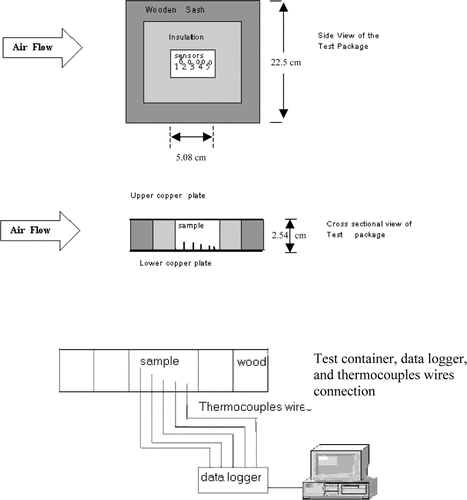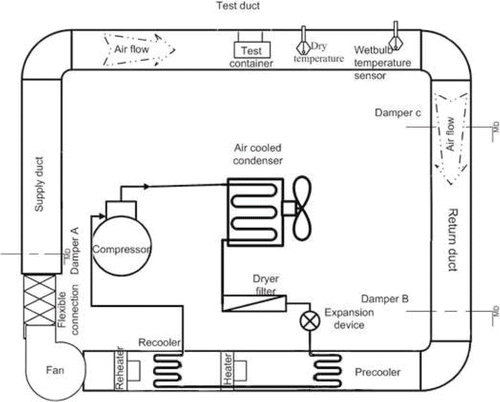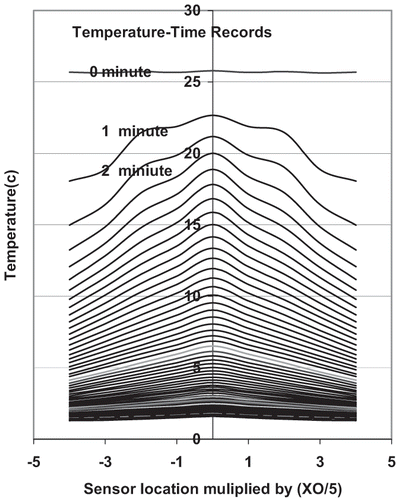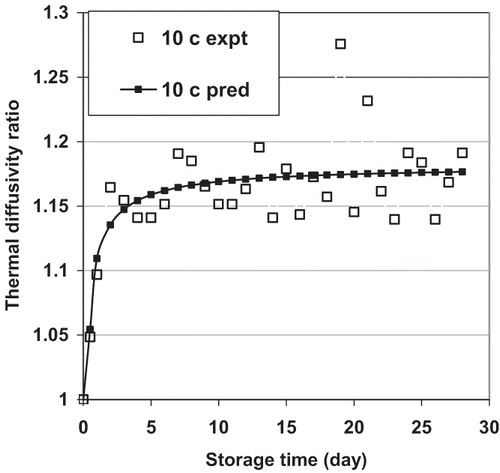Abstract
This paper presents the use of thermal diffusivity-variation of Malaysian Pangasius Sutchi freshwater fish as a criterion to estimate the freshness in fish marketing. A homogenous specified area of a fresh fish body was cut into slices which were wrapped and preserved in a cold store of 10°C for a period of 28 days. Ansari's approach has been found earlier as an appropriate one to measure the thermal diffusivity of fish through transient cooling. The daily measurement of those slices (samples) along the muscle orientation revealed that thermal diffusivity increased up to 3 days then stayed approximately constant up to the end of the preservation period (28 days). In the literature the shelf life was also found 3 days at 10°C, which in turn agreed with the present investigation. Regression analysis was made to develop an empirical correlation between thermal diffusivity ratio and preservation time of the fish under study. This correlation could be used by food technologists as an index of deterioration of freshness or consumer acceptance
INTRODUCTION
Knowledge of thermophysical properties of foods and their variations is very important for making heat transfer analysis. Thermal diffusivity is the most important thermal property, as it includes the effects of properties like mass density, thermal conductivity, and specific heat capacity.
During the course of cold preservation of fish, many chemical and biochemical changes occur in the fish tissues, which eventually lead to its spoilage.[Citation1] These changes influence the thermophysical properties of fish during the course of its deterioration. As soon as a fish dies, spoilage begins. Spoilage of fresh fish is a rather complex process and is caused by a number of inter-related reactions, some of which are suppressed by others. The factors that principally contribute to the spoilage are the degradation of protein with subsequent formation of various products like hypoxanthine, trimethylamine, development of oxidative rancidity and the action of microorganisms.[Citation2] So, the spoilage process will bring about changes in texture of the flesh and consequently will influence the apparent thermal diffusivity, which is a comprehensive property. The enzyme action causes spoilage after death and thus brings out self-digestion, affecting the flavor, texture, and appearance of the fish. The rate of self-digestion is much dependent on temperature. Chilling of the fish to just above the freezing point does not stop but retards self-digestion. Heating can stop enzyme action, and it is controlled to some extent by other methods, such as salting, frying, drying, and marinating.
The objective of the present investigation is to study the variation of thermal diffusivity of fresh water fish of Malaysian origin during its preservation in an unfrozen state. An attempt is made to use this important thermophysical property as an indicator of consumer acceptance. If a correlation may be developed between the preservation time and thermal diffusivity, this would give a basis of digitally defining the quality of cold preserved fish, which is yet not known and which may eventually be a good tool for food technologists.
MATERIAL AND METHODS
Thermal Diffusivity Estimation
Air-cooling of food packages involves only heat transfer from its surface. Mathematical modeling and analysis of such problems is easy. Both classical and numerical solutions of such problems have been reported by many investigators.[Citation3–10] The surface film conductance values required to make these solutions are those calculated from the Nu-Re correlations available in the literature.[Citation3,Citation11–13] Graphical solutions have also been reported.[Citation14–15]
The generalized dimensionless transient heat conduction equation for isotropic solids during symmetric cooling with no internal heat generation can be written as:
If the sample is initially at a uniform temperature and pure convection heat transfer takes place, the initial conditions and the surface and center boundary conditions will be defined respectively by the following equation:
The previously stated equation system is solved to predict temperature-time variation during cooling either by classical methods or by numerical techniques. Numerical methods, like finite-difference and finite element, are very extensively used these days. Out of the two numerical methods, finite-difference technique is more prevalent. For solving the equation system, the thermophysical properties and system parameters should be known before hand. It was reported[Citation16] that explicit finite difference scheme yields quite satisfactory results.
Surface film conductance needed to solve the equation system was calculated from the Nu-Re relations it in the following generalized form.
The chilled air properties used to solve EquationEq. (5), were read from property tables at the mean temperature. The thermal conductivity of the fish was determined from the measured mass fraction[Citation13] of all the constituents content such as water, protein, carbohydrate, fat, and ash as follows:
With known properties and system parameters, Eqs. (1–4) are solved to numerically generate temperature-time variation of any food product. Conversely, if experimental temperature-time record is known, the same scheme can be used to predict any unknown property or system parameter. It was reported[Citation3] that this method was employed to determine thermal diffusivity as well as surface film conductance. During investigations, it was observed that the scheme was not always convergent. Sometimes, quite absurd results were obtained, which were discarded. This problem was not encountered while making temperature calculations. Later, to overcome this problem, an empirical equation was developed and reported[Citation5] to replace the above system of equations with a single algebraic equation as given below.
Making least square analysis of numerically generated data developed the above equation. Methodology used has been thoroughly explained[Citation3] in the literature that EquationEq. (7) was found to be valid for ≤ X ≤ 0.6 and Fo > 0.4. EquationEq. (7) is capable of making a thorough heat transfer analysis during cooling of solid and liquid bodies. It makes the calculation procedure very simple and hand calculation may be adequate for it. Later, it was demonstrated[Citation17] that the equation yielded highly reliable results both for temperature calculations and property determination. The convergence problem associated with the numerical schemes for determining thermal properties and system parameters did not occur. With known temperature-time history, it was successfully used to determine the thermal diffusivity or surface film conductance. It was also demonstrated to be a superior method in that it yielded effective values of thermal diffusivity and surface film conductance, which included the effect of moisture evaporation from the products exposed to chilled air stream. When these effective values were used to calculate temperature, the agreement with measured temperatures was superior to that by other heat and moisture schemes available in the literature.[Citation18] During later experimental investigations[Citation19,Citation20] on fish products, (EquationEq. 7) was found to be the most reliable approach to calculate the thermal diffusivity via precooling process.
Accordingly the above model was used to determine the thermal diffusivity of fish samples and its variation with preservation time in unfrozen refrigerated state through temperature-time measurements when it was cooled in chilled air stream.
Experimental Set Up and Procedure
The experimental test rig has been designed and fabricated for air blast cooling of fish slices (samples). The schematic diagram of the test set-up has been shown in . It consisted of a 4 m long galvanized iron sheet air-duct of 0.33 m × 0.31 m rectangular cross section which was insulated with 15 mm thick glass wool. The air was cooled by passing it over the cooling coils (precooler and recooler) of a R-22 refrigeration system with the help of centrifugal fan. The temperature of the circulating air inside the test duct was maintained constant at 1°C and controlled through the adjustable pre-heater, heater and defrosts heater. The dampers A, B, and C were provided to control the circulation rate of air passing over the test sample. The velocity of chilled air was kept constant throughout all the experiments at 6 m/s.
The test sample was prepared such that one dimensional heat transfer could take place. Fish pieces were cut with uniform thickness of 2.54 cm. A fish piece was held between two 0.1 mm thick copper plates as shown in . The remaining four faces were thermally insulated so as one-dimensional heat transfer could take place. For symmetrical cooling, the sample was suspended in the chilled air stream such that the conducting copper faces were parallel to the direction of the air stream. In order to fix the sample inside the test duct, two pairs of insulated hooks were attached to the inside of the upper and lower surfaces of the test duct. The test sample container was fastened to the upper and lower hooks with the help of thin cotton threads to avoid heat conduction. If Xo is the characteristic length (half thickness) of the fish sample, five copper-constantan thermocouples were put inside the flesh at the depths Xo /5, 2 Xo /5, 3 Xo /5, 4 Xo /5, and Xo from the surface. In order to make it possible to insert the thermocouples at the desired depths, five fine holes were drilled at equal distances of 5 mm from each other on one of the copper sheets. The temperatures inside the fish flesh, and the dry bulb and wet bulb temperatures of the circulating air were measured with the help of 2 copper-constantan thermocouples. The lead wires of all the thermocouples were connected with a data logger to obtain simultaneous temperature measurements at a specified equal time interval of one minute. Measurements on each sample were made for 60 minutes, when the temperature along the central plane approached the cooling air temperature within 0.5°C.
A fresh lot was purchased from the market. It was ascertained that all the fish was in the same age group. Sufficient numbers of uniformly 2.54 mm thick pieces were cut so as they could be used for 28 days of experimentation. Three pieces of fresh fish were used for the first day and the rest were preserved in a refrigerator at a uniform temperature of 10°C. The air cooling system was first run for nearly half an hour so as a steady temperature of 1°C was attained. The fish sample was first packed into test container, thermocouples were fixed at desired depths and the container was suspended properly inside the chilled air duct. As soon as fish sample was suspended, the data logger was switched on, and it was programmed to record temperatures at each one-minute time interval. On the first day, tests were carried out on three fresh samples. On subsequent days, three cold preserved fish samples were taken out from the refrigerator, first kept at the room temperature until their temperatures were stabilised to room temperature. Tests were then performed one by one on the three samples and data was collected for 28 days, until the fish was completely rotten.
RESULTS AND DISCUSSION
The transient temperature-time data was used to calculate thermal diffusivity by EquationEq. (7). Average value was calculated for each day. As discussed earlier, EquationEq. (7) gives accurate results during linear temperature variations. shows a typical temperature-time plot, in which initial temperature drop is fast and non-linear. This non-linear portion must be omitted while determining thermal diffusivity. As discussed earlier, similar inaccuracies occur when time temperature history near the surface is used. Due to these considerations, all the calculations were made for temperature records at 0 ≤ X ≤ 0.6 and Fo > 0.4.
Three samples each day and four temperature time records on each sample, thermal diffusivity values were calculated. Average value was calculated for each day and averaging was done both for all the samples tested that day and all points. Average thermal diffusivity values were plotted against the days of preservation. The scatter of the values has been plotted in , which also shows the best-fit curve with standard deviation of 0.028. Attention should be drawn to the fact that the appreciable scattering is commonly shown in food processing researches papers especially those concerning the variation of thermal diffusivity of fish as obviously observed by earlier investigators.[Citation21–23]
It was observed that after 3 days of preservation time at a temperature of 10°C, thermal diffusivity becomes constant. The literature review shows that at 10°C the acceptable life of fish is also 3 days.[Citation24–25] This shows a trend between the fish quality and one of its important sensory properties. When thermal diffusivity data was analyzed by least square method, the following correlation was obtained with standard error of 0.03 and correlation coefficient of 0.76 for the thermal diffusivity ratio (α /αfresh) as a function of days of preservation
The previous correlation may be used as an index of deterioration, which could be related to freshness or consumer acceptance.
CONCLUSION
During the course of preservation, the fish material will be subjected to physical-chemical changes due to quality deterioration, which affects the value of the thermal diffusivity property. The results revealed that the increasing behaviour of α during the preservation time can be recognized into two intervals, the first one shows high increase whereas the property tends to stabilize in the second interval. Although this output is essential information for heat transfer equipment designer, the present authors used this information to develop new freshness index. A correlation has been developed for α/αfresh as a function of preserved time and temperature, on the basis of above function value the degree of freshness may be determined. The value of 1.0 means absolutely fresh, and the far above 1.0, the far of freshness state. This index may be used as tool by food technologist to measure the freshness of a fish batch.
NOMENCLATURE
| Bi | = |
Biot number (h · xo/k) |
| cp | = |
specific heat of fish (J/kg · K) |
| h | = |
surface film conductance (W/m2 · K) |
| k | = |
thermal conductivity (W/m · K) |
| Nu | = |
Nusselt number (=h · xo/kair) |
| Pr | = |
Prandtl number |
| Re | = |
Reynolds number (=v · xo/γ) |
| t | = |
time (s) |
| T | = |
temperature (°C) |
| U | = |
normalized temperature [=(T– Tcm)/(Ti – Tcm)] |
| W | = |
water content, % (on wet mass basis) |
| x | = |
distance from central plane (m) |
| X | = |
normalized space coordinate (=x/xo) |
| x0 | = |
Half thickness or radius (m) |
| Xa | = |
mass fraction of ash |
| Xc | = |
mass fraction of carbohydrate |
| Xf | = |
mass fraction of fat |
| Xp | = |
mass fraction of protein |
| Xw | = |
mass fraction of water |
| Z | = |
number of days of cold preservation |
| Greek Letters | = | |
| γ | = |
kinematics viscosity of air at mean temperature (m2/s) |
| α | = |
thermal diffusivity of (m2/s) |
| Fo | = |
Fourier number (α · t/xo 2) |
| Subscripts and Superscripts | = | |
| cm | = |
cooling medium |
| o | = |
initial |
Notes
2. Abdullah, M.S. Freezing Studies on a Model System and Quality Changes in Frozen Malaysian Fish. Ph.D Thesis, Faculty of Engineering, Universiti Putra Malaysia Malaysia. 1985.
3. Ansari, F.A. Heat and Mass Transfer Analysis in Cold Preservation of Food. Ph.D. Thesis. University of Roorkee, Roorkee, India. 1984.
22. Radhakrishnan, S. Measurement of Thermal Properties of Seafood. M.Sc. Thesis Virginia Polytechnic Institute and State University, 1997.
24. Hafiz, M.I. Lipid Oxidation in Some of Malaysian Freshwater Fish. Bachelor of Science, Thesis, Faculty of Food Science and Biotechnology, Universiti Putra Malaysia, Malaysia, 2000.
25. Doyle, J.P. Seafood shelf life as a function of temperature. Alaska Sea-Gram, No. 30. Marine Advisory Program, University of Alaska, Fairbanks, 1989.
REFERENCES
- Connell , J.J. 1990 . Control of Fish Quality , 3rd , London : Fishing News Books, Blackwell Scientific Publications .
- 2. Abdullah, M.S. Freezing Studies on a Model System and Quality Changes in Frozen Malaysian Fish. Ph.D Thesis, Faculty of Engineering, Universiti Putra Malaysia Malaysia. 1985.
- 3. Ansari, F.A. Heat and Mass Transfer Analysis in Cold Preservation of Food. Ph.D. Thesis. University of Roorkee, Roorkee, India. 1984.
- Ansari , F.A. 1986 . An empirical method of measuring thermal diffusivity and surface film conductance . ASAE Trans , 29 ( 5 ) : 1492 – 1497 .
- Ansari , F.A. 1987 . A simple and accurate method of measuring surface film conductance for spherical bodies . Int. Communications in Heat and Mass Transfer , 14 : 229 – 235 .
- Baird , C.D. and Gaffney , J.J. 1976 . A numerical procedure for calculating heat transfer in bulk loads of fruits and vegetables . ASHRAE Trans , 82 ( 2 ) : 525 – 540 .
- Dincer , I. 1993 . An exact heat transfer analysis of spherical products subjected to forced air cooling . International Journal of Energy Research , 17 ( 1 ) : 9 – 18 .
- Hayakawa , K.I. 1972 . Estimation of temperatures of foods during various heating and cooling treatments . ASHRAE Journal , 14 ( 9 ) : 65 – 70 .
- Pflug , I.J. , Blasdell , J.L. and Kopelman , I.J. 1965 . Developing temperature-time curves for objects that can be approximated by sphere, infinite plate or infinite cylinder . ASHRAE Trans , 71 ( 1 ) : 2319 – 2365 .
- Pflug , I.J. and Kopelman , I.J. 1966 . Correlating and predicting transient heat transfer rates in food products, Bull . International Journal of Refrigeration, Annexe , 2 : 89 – 95 .
- Chapman , A.J. 1984 . Heat Transfer , 4th , New York : MacMillan Publishing Co .
- Zogzas , M.K. , Krokidia , M.K. , Michailidis , P.A and Maroulis , Z.B. 2002 . Literature data of heat transfer coefficients in food processing . International Journal of Food Properties , 5 ( 2 ) : 391 – 417 .
- Rahman , M.S. 1995 . Food Properties Handbook , New York : CRC Press .
- Gurnie , H.P. and Lurie , L. 1923 . Charts estimating temperature distribution in heating or cooling solid shapes . Industrial and Engineering Chemistry , 15 : 1170
- Heisler , M.P. 1947 . Temperature charts for induction and constant temperature heating . ASME Trans , 69 : 227 – 236 .
- Ansari , F.A. 1999 . Finite difference solution of heat and mass transfer problems related to precooling of food . Energy Conversion & Management , 40 : 795 – 802 .
- Ansari , F.A. , Mughis , A. and Ahmad , M. 1987 . Measurement of thermophysical properties of mashed potato . Lebensm.-Wiss. U-Technol , 20 ( 6 ) : 267 – 270 .
- Badri , N.K. and Krishna , M. M. V. . Heat and mass transfer characteristics and the evaluation of thermal properties of moist spherical bodies . Proceeding of the 4th National Conference on Heat and Mass Transfer . Nov. 21–23 , India : University of Roorkee .
- Sapuan , S.M. , Abbas , K.A. , Mukhtar , A.S. and Jamilah , B. 2003 . Comparative study in thermal diffusivity measurement methods stability of Malaysian Pangasius Sutchi . Journal of Energy Heat and Mass Transfer , 25 : 217 – 230 .
- Abbas , K.A. , Megat , M.M.H. , Sapuan , S.M. , Mukhtar , A.S. and Jamilah , B. 2005 . Determination of thermal conductivity of Malaysian patin fish . Journal of Food, Agriculture and Environment , 3 ( 1 ) : 44 – 48 .
- Nesvada , P. and Eunson , C. 1984 . Moisture and temperature dependence of thermal diffusivity of cod minces . Journal of Food Technology , 19 : 585 – 590 .
- 22. Radhakrishnan, S. Measurement of Thermal Properties of Seafood. M.Sc. Thesis Virginia Polytechnic Institute and State University, 1997.
- Kee , W.L. , Ma , S. and Wilson , D.I. 2002 . Thermal diffusivity measurements of pet food . International Journal of Food Properties , 5 ( 1 ) : 145 – 151 .
- 24. Hafiz, M.I. Lipid Oxidation in Some of Malaysian Freshwater Fish. Bachelor of Science, Thesis, Faculty of Food Science and Biotechnology, Universiti Putra Malaysia, Malaysia, 2000.
- 25. Doyle, J.P. Seafood shelf life as a function of temperature. Alaska Sea-Gram, No. 30. Marine Advisory Program, University of Alaska, Fairbanks, 1989.



